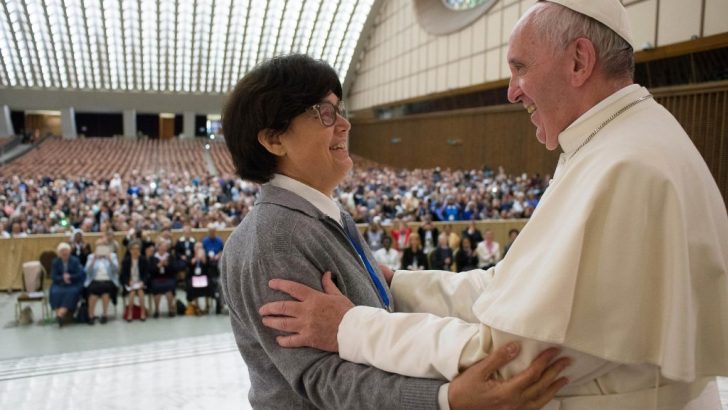Women were ordained as deacons in the past, the question now is will they be in the future, writes Phyllis Zagano
Pope Francis arrives in Dublin on August 25 for the World Meeting of Families. That’s the feast of St Louis, the 13th Century French King who left his wife and 11 children at home while he led the Seventh Crusade. And it’s him they canonised!
Coincidences aside, the point is well taken. Who does the work of the family? And, who does the work of the Church? Clearly, the Church in Ireland depends on its faithful women more than ever, given its dearth of priests, slow-growing diaconate, and increasing needs for ministry.
If the question is about ministry, the answer could be women.
So, what can the Pope do for Ireland? Of course, there are some things he cannot do. No matter the needs, he cannot recommend the ordination of women as priests. The varied reasons have differing levels of authority, but the Church teaches that women cannot be ordained as priests. Some say women cannot receive the Sacrament of Holy Orders, but Catholics can receive any Sacrament unless impeded by divine or ecclesiastical law. If the ban against women priests is both, the matter is settled. But, the Church needs ministry, and the diaconate is not the priesthood.
Tensions arose
The deacon is a sacramentally-ordained minister who can manage parish affairs, oversee catechesis, perform weddings and baptisms, and even serve as a single judge in canonical proceedings. Historically, deacons administered the Church’s treasury. They managed the Church’s charity directly. But tensions arose between powerful deacons and priests and by the 12th Century the cursus honorum — the course of honor – became law. No one could be ordained a deacon unless he was destined to become a priest. So, the diaconate of women receded to the monasteries and eventually died out.
In the 20th Century, the Church began to recognise a need to restore the diaconate as a permanent vocation. Following the Second Vatican Council, Blessed Paul VI promulgated two documents. The first re-established the diaconate as a permanent vocation; the second did away with the minor orders of porter and exorcist, made lector and acolyte installed orders, and discontinued the major order of subdeacon.
In 2001, the Irish bishops’ conference began to restore the permanent diaconate and by 2012, Archbishop Diarmuid Martin ordained the first eight male permanent deacons. Today, there are some 80 Irish permanent deacons and at least 16 of Ireland’s 26 dioceses have diaconal formation programmes. None includes women.
Many people ask why. Restoring women to the ordained diaconate has been a world-wide discussion for many years. Irish priests have opposed male-only diaconal formation programmes. Under Bishop Kieran O’Reilly, the diocese of Killaloe cancelled plans for it when women ministers complained.
In August 2016 Pope Francis accepted the suggestion of the Triennial Assembly of the International Union of Superiors General (UISG) and named a Commission for the Study of the Diaconate of Women, which opened in November 2016.
Just last month, Commission president, Cardinal Luis Ladaria, Prefect of the Congregation for the Doctrine of the Faith, told the Vatican press corps that:
l the Pope requested the history of women deacons;
l women deacons did exist;
l it was not the place of the commission to make a recommendation on what the Pope should do.
So, what’s next? Nobody knows. The facts of history are clear: women were ordained as deacons by bishops at the altar in liturgies nearly identical to those for male deacons.
These ordination liturgies included a laying on of hands and an epiclesis, or invocation of the Holy Spirit. The bishop placed the stole around the woman’s neck and handed her the chalice to self-communicate. Importantly, these ordained women were called deacons – or, as language developed, deaconesses.
History documents that women served at the altar as much as male deacons did and that Popes, bishops and even synods increasingly complained and finally banned such altar service due to women’s ‘impurity’.
A 2002 document of the International Theological Commission argued that women deacons’ assigned tasks were not identical to those of male deacons. In many places and times that is true: the Pope pointed out to the UISG assembly that the woman deacon examined the bruises and testified to the bishop on behalf of abused women. No male deacon did that. Such is just one example.
Charity
Different tasks give strong reasons for restoring women to the ordained diaconate. Today’s male deacons cannot minister as women deacons did historically and could do again.
The deacon is dedicated to the Word, to liturgy, and to charity. Today, women provide the Church’s charity. Would the People of God not benefit from women ministers preaching the Word? Would the world not benefit from seeing a vested woman at the altar in the liturgy?
How better to minister to the world and teach the basic Christian principal: all are made in the image and likeness of God?
Phyllis Zagano is senior research associate-in-residence at Hofstra University, Hempstead, New York, USA and was named to the Papal Commission for the Study of the Diaconate of Women by Pope Francis in 2016.


 Pope Francis greets Sister Carmen Sammut, a Missionary Sister of Our Lady of Africa president of the International Union of Superiors General. Photo: CNS
Pope Francis greets Sister Carmen Sammut, a Missionary Sister of Our Lady of Africa president of the International Union of Superiors General. Photo: CNS 